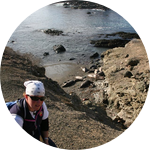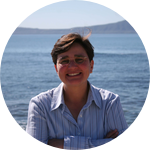Project Results
I am excited to share some of our findings. After the aerial surveys we started to analyze all the pictures, using a specialized software to count each individual with the help of students. We analyzed more than 5000 photographs…a lot of work J but we found very interesting results, with high abundance in three main islands. As I told you before, during field work we deployed 12 VHF tags to estimate a correction factor for precise abundance estimation. That went really great, and we did statistical analysis of the data, so now I can say that we have a correction factor for Pacific harbor seals in Mexico. I´m so excited about this result. At present, we are working on a paper with all this information, and hope to publish it this year :)
During this time, we also downloaded and started with the first preliminary analysis of the SPOT satellite tags. We noticed that two tags transmitted for more than 100 days, while others just transmitted for 9 days…but all of the information is useful. Last November, I took a small course to analyze the geographic information provided by the tags. It showed that females prefer to stay close to their reproduction site with movements of 20 km, while males travel more than 50 km, mainly north of the island. During the next months we will continue with the analysis to describe their marine habitat preference and try to identify their potential distribution in the ocean. This would lead to another paper :)
About posters, talks, or papers that came out of this project, I have been working on data analyses but haven’t presented my results at any conference yet. But this month (January) I´m going to present a poster about the abundance estimation and its corresponding correction factor at the Southern California Marine Mammal Workshop. I’ll be very happy to let the people know what we have been accomplishing with respect to the Pacific harbor seals in Mexico. I also will present the results of this project at the Mexican Society for Marine Mammalogy conference this May. At last, I hope to defend my PhD dissertation this year. I will keep in touch to let you know the news about the papers, conferences, and of course my defense :)
About This Project
Pacific Harbor seals use land to give birth to pups and molt, but once they return to the ocean to forage many seals do not survive. We have been studying this subspecies in Mexico since 2008. We describe their distribution, population size, and feeding habits. The goal of this new project is to describe where seals are traveling by using satellite tags. By knowing where the seals go we can identify important areas for marine conservation.
Ask the Scientists
Join The DiscussionWhat is the context of this research?
We want to know where Pacific harbor seals go after they finish their activities on land. During the Summer and Fall the number of individuals on land decreases because they return to the ocean to forage. In Mexico we have no information about how far these seals travel from their cologies. We also want to know where they are foraging.
Studies of their movements are common in the northern populations where most of the individuals travel up to 30 miles around their haul-out sites. Males travel greater distances than females. We will use satellite tags to collect information on their movements and link this data with surface temperature, productivity, and depth during foraging.
What is the significance of this project?
Pacific Harbor seals are well studied in their northern distribution, but in Mexico the information is scarce. At present our group is starting to understand what’s going on with them, studying them on land. Seals inhabit mostly temperate to cold water species, so Mexico represents their southern limit, probably with suboptimal conditions. Therefore, we think it is important to know how they adapt to this conditions, thus we have extended our studies to the ocean. But this kind of study are difficult because it is not easy to see the animals underwater, that´s why I want to use satellite tags to collect geographic information and try to understand where they are looking for food and what kind of place they prefer for ocean activities. In the end, we will locate hot spots for conservation.
What are the goals of the project?
Our main goal is to travel to Todos Santos island in May 2016 to capture six Pacific Harbor seals (females and males) and deploy satellite tags. We will collect location data for 6 months to describe their movements and identify their ocean preferences with data such as depth, water temperature, and productivity. This information will support the existing proposal to establish the islands west off the Baja California Peninsula as a natural reserve that includes Todos Santos island.
We will collaborate with local fishermen to share the knowledge about the species so they appreciate the importance of harbor seals in the ecosystem. This will probably lead to better understanding of this species’ conservation and maybe they will even take tourists to watch the seals in their natural habitat.
Budget
In May 2016 we will travel to Todos Santos island to deploy six SPOT satellite tags we already have on adult harbor seals. We are asking for the cost to travel to the island and, more importantly, the cost of satellite communication with the ARGOS system to activate and collect data from the SPOT tags.
During the last two years I´ve been enrolled in a harbor seal project that includes land counts, observations and pup captures. This year I will start my field work doing aerial surveys along nine islands and the coast west off Baja California. We will capture 30 individuals to deploy VHF radiotags allready provided to obtain a correction factor and estimate Pacific Harbor seal abundance, and at the same time deploy the SPOT tags of this proposal.
The funds we obtain will be combined with those we received from the Mexican science council, the University of Baja California and Center of Scientific Research and Higher Education of Ensenada (where I am enrolled in a doctoral program).
Endorsed by
Meet the Team
Affiliates
Affiliates
Team Bio
Dr Gisela Heckel and Dr.Yolanda Schramm are researchers who have 20+ years working with marine mammals, since 2007 with pinnipeds in the Baja California peninsula, now focused on the Pacific Harbor seal.
We been working together for 15 years, as part of the NGO Ensenada Marine Mammal Research and Conservation (ICMME), dedicated to marine mammal stranding response and environmental education.
We are capable of working in the field to capture and handle seals for this project.
Denise Lubinsky
I´m an oceanographer in love with the sea, especially with the marine mammals. After I finished my undergraduate studies at the University of Baja California in Ensenada I worked in a research project about bottlenose dolphins in Veracruz, Mexico (Gulf of Mexico). A few months later I came back to Ensenada to study my master’s in coastal oceanography, and for my thesis I had the opportunity to travel to 10 islands west off the Baja California peninsula studying with four pinniped species. I was fascinated with the islands and the field work and I completed my thesis about the distribution and abundance estimation of harbor seals. I presented my results as an oral presentation at the conference of the Mexican Marine Mammal Society in May 2010, and in Novembrer 2011 as a poster at the 20 Biennial Conference on the Biology of Marine Mammals in Tampa, FL. At present a manuscript has been submitted for publication in a scientific journal and we are waiting for news.
When I finished my master’s degree I went to Veracruz again to work as a field coordinator in a manatee project. This gave me the opportunity to try to inspire and teach young students to fall in love with field work and marine mammals. In 2014 I enrolled in the Life Sciences PhD program at the Ensenada Scientific Research and Higher Education Center of Ensenada (CICESE) to continue with my master’s work, answering the questions that I could not answer before. During my first year I was invited by Dr. James Harvey from Moss Landing Marine Laboratories, Oregon, to take part in a harbor seal capturing campaign. The main objective was to learn different techniques to capture adult harbor seals and how to tag and handle them with care.
Gisela Heckel
I am Denise's Ph.D. advisor at the Life Sciences graduate program, CICESE, Mexico. We have been working together since 2002 in several projects regarding marine mammals, so I can say I know her well and she's incredibly committed to every task she embraces.
My career in marine mammalogy started in 1990, when I studied a bottlenose dolphin population in Veracruz, Mexico, for my undergraduate thesis. I graduated in Biology at the National Autonomous University of Mexico in 1992. Then I moved to Ensenada, Baja California, to continue my graduate studies in Oceanography at the University of Baja California. For my master's thesis I studied the evasive behavior of spotted and spinner dolphins during fishing for yellowfin tuna in the eastern tropical Pacific. During my Ph.D. my research was focused on the effects of whale watching boats on the behavior of migrating gray whales along the coast near Ensenada, and I proposed a management program for this tourist activity. Also during my Ph.D. I co-founded an NGO to respond to marine mammal strandings and later on we started an environmental education program regarding these fascinating animals and their conservation problems. I graduated in 2001 and since then I am a professor at the Ensenada Scientific Research and Higher Education Center (CICESE, for its Spanish acronym).
My research interests have expanded to many marine mammal species, their biology, ecology, and conservation issues. California sea lions and Pacific harbor seals have been my focus during the last four years, although I have advised many graduate thesis regarding other species.
Yolanda Chramm
I am a professor and researcher at the Faculty of Marine Sciences, University of Baja California in Ensenada, Mexico. My undergraduate studies were in Biology, and my master’s and doctoral studies were in Coastal Oceanography. My theses were focused on dolphin and sea lion populations, their dynamics, behavior, and genetic structure.
I have published several scientific papers and advised undergraduate and graduate students. I teach in the graduate program in Molecular Ecology and Biotechnology, as well as in the undergraduate program in Oceanography. I advised Denise during her master’s thesis research on the abundance of harbor seals in Mexico.
My research is on seals and sea lions in Mexico and other countries. Part of my studies is focused on genetics and ecology to be applied in management and conservation of vulnerable species. For 18 years I have been participating in an NGO that responds to marine mammal strandings along the coast of Ensenada, Baja California.
Additional Information
http://wildlifecomputers.com/our-tags/spot/ This is the website of the satellite tag we already have.
http://www.marinemammalcenter.org/ Website of a marine mammal center
LOS DONATIVOS EN PESOS PUEDEN SER DEPOSITADOS A MI CUENTA...CONTACTENME PARA MAYOR INFORMACION
Project Backers
- 31Backers
- 102%Funded
- $5,100Total Donations
- $123.55Average Donation



